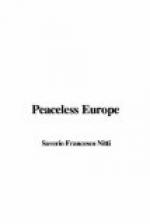The situation of German-Austria is now such that she can say with Andromache: “Let it please God that I have still something more to fear!” Austria has lost everything, and her great capital, which was the most joyous in Europe, shelters now a population whose resources are reduced to the minimum. The slump in her production, which is carried on amidst all the difficulties, the fall in her credit, the absolute lack of foreign exchanges, the difficulty of trading with the hostile populations which surround her, put Austria in an extremely difficult position and in progressive and continuous decadence. The population, especially in the cities, is compelled to the hardest privations; the increase of tuberculosis is continuous and threatening.
Bulgaria has had rather less loss, and although large tracts of Bulgarian territory have been given without any justifiable motive to Greece and Jugo-Slavia, and although all outlet on the Aegean has been taken from her by assigning to Greece lands which she cannot maintain, on the whole Bulgaria, after the Treaty of Neuilly, has less sharp sufferings than the other conquered countries. Bulgaria had a territorial extension of 113,809 square kilometres; she has now lost about 9,000 square kilometres. She had a population of 4,800,000, and has lost about 400,000.
As for Turkey, if the treaties should continue to exist, she can be considered as disappearing from Europe and on the road to disappear from Asia. The Turkish population has been distributed haphazard, especially to Greece, or divided up under the form of mandates to countries of the Entente. According to the Treaty of Sevres of August 10, 1920, Turkey abandons all her territory in Europe, withdrawing her frontier to the Ciatalgia lines.
Turkey in Europe is limited, therefore, to the surroundings of Constantinople, with little more than 2,000 square kilometres, and a population which is rather hard to estimate, but which is that only of the city and the surroundings—perhaps a million and a half men. In Asia Minor Turkey loses the territory of the Sanjak of Smyrna, over which, however, she retains a purely nominal sovereignty; the territory still undefined of the Armenian Republic: Syria, Cilicia, Palestine and Mesopotamia, which become independent under mandatory powers; in Arabia the territory of the Hedjaz, whilst the remainder of the peninsula will enjoy almost complete independence. Besides, Constantinople and the Straits are subject to international control, and the three States now the most closely interested—Great Britain, France and Italy—assume the control of the finances and other aspects of the Ottoman administration.




